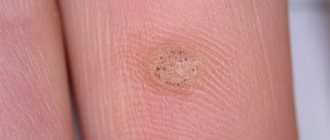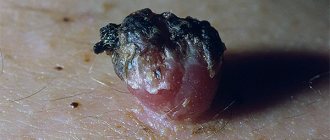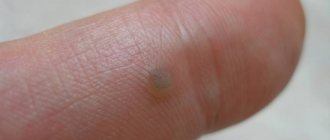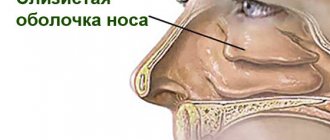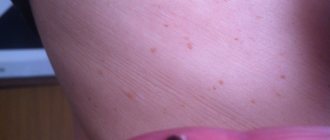If a papilloma suddenly becomes inflamed, there is no need to immediately panic. This phenomenon can be explained by completely harmless factors.
To find out exactly the cause of the disorder, you will have to consult a dermatologist. He will invite the patient to undergo a series of simple tests, the results of which will make it clear whether one should be wary of the newly identified symptoms and the papilloma itself.
If a papilloma is inflamed under the armpit or on another part of the body, the first thing you should do is find out the reason for this. Only rarely does this process occur spontaneously.
Doctors name a number of factors that explain why the tumor has changed. The following is a list of reasons that answer the question of why papillomas become inflamed:
- Injury of viral formation. Sometimes papillomas are located in very inconvenient places, which is why they are constantly injured. Such growths are damaged by nails, clothing, jewelry or a razor.
Pathogenic microorganisms easily penetrate damaged tissue. They are the ones responsible for the onset of the inflammatory process, which causes a change in the color of the papilloma;
- Strong emotional experience.
If the papilloma is red and painful, you need to try to remember whether the patient has recently experienced serious stress. After all, it can also lead to similar problems;
- Hormonal imbalance caused by pregnancy or long-term medication use.
For this reason, not only swelling of the papilloma occurs, but also a change in its usual shape;
- Hereditary factor.
It can also lead to an exacerbation of the disease and affect already formed growths;
- Prolonged exposure to ultraviolet rays.
If the papilloma is inflamed and red, it is possible that the person spent too much time in the sun.
- The papilloma can become inflamed due to trauma during shaving. These are not all the factors that explain why the papilloma is swollen and swollen.
- Swelling is often associated with the fact that a person abuses alcohol and smokes.
Bad habits negatively affect not only the development of the disease, but also the condition of the entire body.
- The neoplasm in patients with papillomavirus can also swell due to problems in the gastrointestinal tract and pathologies of the endocrine system.
Signs of inflammation
If a papilloma on the neck or other part of the body is inflamed, it is difficult not to notice. This disorder is recognized by its characteristic symptoms.
Causes of pain
Neoplasms do not change just like that: pain can be caused by both external and internal influences. If papillomas turn red and hurt, this indicates the presence of an inflammatory process.
Among the endogenous causes causing this condition, the most common are:
- Exacerbation of the disease. Worsening of papilloma can be caused by the presence of a chronic or genetic disease. In this case, it is necessary to carry out therapy aimed not only at relieving inflammation, but also at treating the provoking disease.
- Overvoltage. Stress causes serious changes in the body. It depletes the patient's strength and can lead to reddening of the papilloma.
- Hormonal disorders. This point applies more to women in whom an imbalance may be caused by pregnancy, thyroid diseases, pathologies of the reproductive system, etc.
Exogenous causes include:
- Mechanical damage. The most common method of injury is a razor cut. This is especially dangerous if the papilloma is located in the armpits, genitals or face.
- Rubbing the buildup. If the tumor constantly rubs against clothing or jewelry, this can lead to injury and infection.
- Long exposure to the sun. Ultraviolet rays can have an unpredictable effect on all neoplasms. Therefore, doctors recommend that people with moles or papillomas spend less time in the sun and not sunbathe in a solarium.
- Self-treatment of growth. If a patient tries to remove papillomas at home using cauterization or cutting, this can lead to their inflammation.
It is very easy to injure a neoplasm: the skin where the papilloma is localized is usually thin. Sometimes even minor exposure is enough to cause redness and irritation.
Another condition that accompanies painful sensations is blackening of the papilloma. A change in pigmentation color is an indicator of changes occurring in the structure of the growth. Possible reasons include:
- the presence of infection due to trauma to the growth;
- onset of cancer;
- trying to get rid of papilloma on your own;
- complications after surgery to remove a tumor.
If the papilloma turns black and begins to dry out, this indicates that it is beginning to separate from the skin. This can usually be observed if the patient tried to remove it using various means. This process is considered safe. It is recommended to take the fallen papilloma for histological examination to ensure its benignity.
Dangerous symptoms and complications
Under the influence of the considered factors, an inflammatory process develops in the tissues of the neoplasm, which is characterized by typical symptoms:
- the papilloma has turned red and dried out (this often happens when the upper layers of the skin are traumatized, then the formation becomes covered with a crust),
- increased in size, swollen,
- the inflamed area may hurt and itch both under mechanical stress and in a calm state,
- the patient may experience a slight increase in body temperature (no more than 37.5 degrees).
With such symptoms, you should consult a doctor for timely treatment. If help is not provided, the situation will progress - if the papilloma is inflamed, then this condition is unlikely to go away on its own. In this case, other symptoms that are more dangerous may appear:
- blood is released from the neoplasm,
- suppuration develops,
- the increase is occurring at a very rapid pace,
- the inflamed papilloma begins to hurt more,
- there is a change in the color, shape and texture of the formation (the most common situation is darkening).
The described signs, especially in combination, indicate malignancy of papilloma, that is, its transformation from a benign to a malignant form (some HPV strains have an extremely high degree of oncogenicity).
Degeneration is the most dangerous complication; it carries risks not only for the health, but also for the life of the patient, so you should not delay when the first symptoms of the inflammatory process appear.
How is the treatment carried out?
Therapy involves the mandatory removal of disturbing growths. In this case, the doctor not only destroys the tumor, but also prescribes antiviral drugs, as well as immunomodulators to boost immunity. Among the most common means are:
- Allokin-alpha;
- Panavir;
- Viferon;
- Cycloferon;
- Isoprinosine.
Initially, the patient must undergo conservative treatment designed to relieve symptoms and prevent the patient’s condition from worsening. As part of this method, it is necessary to carry out antiseptic treatment.
It is prescribed to prevent infection from entering the injured papilloma.
For treatment, you can use chlorhexidine or hydrogen peroxide. After the procedure, it is necessary to seal the wound with a bandage. It is forbidden to use brilliant green or iodine!
Such measures are temporary and require further therapy. If the injured tumor causes pain, it must be removed. There are radical treatment methods for this:
- Surgical removal. Used for large growths or a large number of growths. It is used quite rarely, since complications such as infection and bleeding are possible after surgery.
- Electrocoagulation. The method is based on the action of high-frequency current passing through the papilloma. The current leads to the death of cells in the affected area. This method is popular due to its availability and low cost, but can leave scars on the skin.
- Cryodestruction. The growth is frozen using liquid nitrogen, which has a very low temperature. The method is gentle and more painless compared to the previous ones. It does not require anesthesia or general anesthesia. However, during the procedure it is difficult to control the force of the impact, as a result of which a small burn or even a scar may remain on the skin.
- Radio wave removal. One of the most progressive methods. It is based on the action of radio waves and allows you to remove growths without contact. The surrounding skin is not damaged, so the risk of injury is minimal.
- Laser destruction. The effect also occurs without contact: the laser beam cuts off growths like a scalpel, but does not come into contact with the skin. The laser seals the capillaries, which prevents the risk of infection and instantly stops bleeding.
First aid for injuries
If the damaged papilloma turns red, swells, begins to bleed, and other signs of damage to the integrity of the skin appear, first aid measures must be taken to minimize the risk of infection:
- treatment with hydrogen peroxide is required to stop bleeding,
- antiseptic treatment is necessary for disinfection (Chlorhexidine is best suited),
- the inflamed area should be anointed with iodine and covered with a band-aid to prevent re-injury.
In the near future, you should contact a dermatologist for examination and removal of the injured papilloma due to the risk of malignancy. If this is not immediately possible, then it is necessary to monitor the formation, monitoring dangerous symptoms.
Folk remedies
If pain occurs and the pigmentation of the growth changes, it is not recommended to carry out independent therapy. The patient needs to use antiseptics to help prevent infection.
After disinfection, the papilloma must be shown to a doctor so that he can prescribe appropriate treatment.
It is prohibited to use products containing aggressive components. These include:
- iodine;
- celandine;
- vinegar.
Their properties can aggravate the inflammatory process and cause irritation of the skin.
Prevention of inflammation
To reduce the risk of relapse of the disease, you need to regularly adhere to the following rules:
- Carry out personal hygiene daily so that the human papillomavirus does not have favorable conditions for reproduction;
- Try not to rub your clothes against growths on your body;
- If the papilloma comes off, it is necessary to treat the injured area of the skin with an antiseptic, and then protect it from infections with a bandage or bandage it;
- Try not to overwork yourself, avoid nervous breakdowns;
- Make sure that the protective functions of the immune system are ready to resist the virus. During the period of vitamin deficiency, it is recommended to drink special complexes of vitamins and minerals.
It is better to carry out therapy for human papillomavirus as soon as the inflammatory process begins.
Timely diagnosis and treatment will help quickly relieve the symptoms of the disease and avoid further complications.
If you find an error, please select a piece of text and press Ctrl+Enter. We will definitely fix it, and you will get + to karma
[youtube.player]
Benign neoplasms are a problem that many people face, regardless of age and gender. When papillomas appear on the body, the only sure way is to remove them. At this stage, it is important to choose the right clinic that will perform this procedure, as well as decide on the methodology. It is these factors that determine whether there will be complications after removal of papillomas. In addition, full compliance with the doctor’s instructions plays an essential role. If you neglect his recommendations, you may encounter inflammation after removal of the papilloma.
Pain after papilloma removal
Pain in the area of papilloma removal is possible during the first 24 hours after the operation. The skin in this area is inflamed and there may be swelling. The patient may also feel itching, which indicates the healing process.
The severity of symptoms depends on how large the growth is. The larger the tumor, the stronger the pain may be. Moreover, the presence of unpleasant sensations does not depend on the method by which the papilloma was removed. Normally, pain should subside within 24 hours. There should be a small wound in the affected area that requires constant treatment.
If a compaction occurs at the removal site, which is characterized by inflammation and pain on palpation, this is considered a complication. Symptoms such as these may indicate the presence of an abscess, which requires immediate medical attention. He must open and clean the seal. After this, a course of antibiotics is prescribed.
Even successful removal will not completely guarantee the absence of new papillomas. Growths may appear during periods of weakened immunity, since the papillomavirus does not completely disappear from the host’s body. Therefore, it is necessary to prevent relapses.
It is important not to try to treat papillomas on your own if they suddenly change structure, color and respond with pain upon palpation. Any trauma to the growth can be dangerous, so therapy should be entrusted to specialists.
Why do they appear?
The most common cause of inflammation of papilloma is its mechanical damage, for example:
- When rubbing against clothing and jewelry;
- When shaving;
- When scratching itchy papillomas.
Following damage to the epidermis, infection by microorganisms occurs. An inflammatory reaction begins in the adjacent tissues and the growth itself. It may swell and darken and bleed. It may itch and hurt, causing a burning sensation. In the absence of timely antiseptic treatment, pus may flow from the inflamed wound, and the tissue may turn black as a result of the death of its cells.
Injured papillomas are more common in the neck, armpits, groin, and in women under the breasts.
CAREFULLY
An ordinary wart or papilloma can become a cancerous melanoma at any time! To protect yourself...”
Warts on a child's face
If papilloma appears, this already means infection with a virus.
Diagnostics
You can even identify a papilloma from a photo, this neoplasm has such characteristic features.
But only a specialist can make an accurate diagnosis, differentiate your growth from similar ones, identify the degree of danger of the wart and the prognosis of the disease.
In addition to the usual examination through a dermatoscope, which allows you to examine the smallest nuances of the appearance of papilloma, the doctor may need the results of additional studies:
- cytological analysis - a study of the cellular structure of the neoplasm is carried out in order to determine its benignity;
- PCR (polymerase chain reaction) - as a result of the study, the diagnosis of papillomavirus is confirmed if its DNA is detected in the cells of the neoplasm;
- histological examination is also a diagnostic method, although it is carried out after removal of the wart, it allows one to determine the good quality of the removed material;
- Digene test - allows you not only to identify HPV, but also to determine its type, the possibility of degeneration and the degree of spread in the body.
Without these studies, it will be difficult for a doctor to choose the right treatment tactics and achieve maximum effectiveness.
